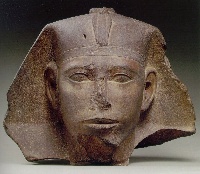Pyramids had their practical importance in the eyes of the kings and their subjects. The king was considered a divine being who held sway over them, and on his departure from this earth he would again ascend to the gods whence he had come. The pyramids soaring up to the sky would probably help him to make his ascent. In any case they would preserve his sacred body from decay.
|
Standing man Early Fourth Dynasty Painted quartzite Height 89.5 cm (35 1/4 in) The Metropolitan Museum of Art, New York 
Two bracelets of Queen Hetep-heres I
Head of King Djedefre
Hemiunu seated
King Khafre seated
Pair statue of Memi and Sabu standing
King Menkaure and a Queen
|





